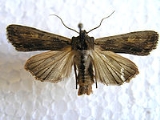
Lithophane semibrunnea
Encyclopedia
The Tawny Pinion is a moth
of the Noctuoidea
family. It is found in scattered populations in North Africa
, Central and Southern Europe
and the Middle East
.
The wingspan
is 40–44 mm. The moth flies in late autumn.
The larvae mainly feed on Fraxinus excelsior.
Moth
A moth is an insect closely related to the butterfly, both being of the order Lepidoptera. Moths form the majority of this order; there are thought to be 150,000 to 250,000 different species of moth , with thousands of species yet to be described...
of the Noctuoidea
Noctuoidea
Noctuoidea is the superfamily of noctuid or "owlet" moths, and has the largest number of species described for any Lepidopteran superfamily. Its classification has not yet reached a satisfactory or stable state. The most recent classifications include only four families in the superfamily;...
family. It is found in scattered populations in North Africa
Africa
Africa is the world's second largest and second most populous continent, after Asia. At about 30.2 million km² including adjacent islands, it covers 6% of the Earth's total surface area and 20.4% of the total land area...
, Central and Southern Europe
Europe
Europe is, by convention, one of the world's seven continents. Comprising the westernmost peninsula of Eurasia, Europe is generally 'divided' from Asia to its east by the watershed divides of the Ural and Caucasus Mountains, the Ural River, the Caspian and Black Seas, and the waterways connecting...
and the Middle East
Middle East
The Middle East is a region that encompasses Western Asia and Northern Africa. It is often used as a synonym for Near East, in opposition to Far East...
.
The wingspan
Wingspan
The wingspan of an airplane or a bird, is the distance from one wingtip to the other wingtip. For example, the Boeing 777 has a wingspan of about ; and a Wandering Albatross caught in 1965 had a wingspan of , the official record for a living bird.The term wingspan, more technically extent, is...
is 40–44 mm. The moth flies in late autumn.
The larvae mainly feed on Fraxinus excelsior.

